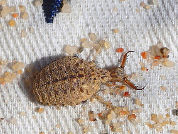Effect of density, disturbance and food on displacement of the Myrmeleon brasiliensis (Navás 1914) (Neuroptera, Myrmeleontidae)
DOI:
https://doi.org/10.25260/EA.16.26.2.0.168Resumen
Myrmeleon brasiliensis larvae build funnel-shaped traps in sandy soil to catch their prey, small arthropods, which move on the soil surface. The objective of this study was to observe displacement behavior of the larvae M. brasiliensis due to variations in food availability, trap density and disturbance through laboratory experiments. These results show that in a short period of time, density and distubance affect M. brasiliensis larvae. Possibly, larvae move in an attempt to find a more favorable place for the construction of its pitfall traps, which would be represented by an environment where intraspecific interaction is reduced and free from disturbance of traps.Citas
Barkae, E. D., G. Ohad, and O. Ovadia. 2014. Dangerous neighbors: interactive effects of factors influencing cannibalism in pit-building antlion larvae. Beha Ecol 25(6):1311-1319.
DeClercq, P., and D. Degheele. 1997. Effects of mating status on body weight oviposition, egg load and predation in the predatory stinkbug Podisus maculiventris (Heteroptera: Pentatomidade). Ann Soc Am 90(1):121-127.
Day, M. D., and M. P. Zalucki. 2000. Effect of density on spatial distribution, pit formation and pit diameter of Myrmeleon acer Walker, (Neuroptera: Myrmeleontidae): patterns and processes. Austral Ecol 25(1):58-64.
Devetak, D., and A. E. Arnett. 2015. Preference of antlion and wormlion larvae (Neuroptera: Myrmeleontidae; Diptera: Vermileonidae) for substrates according to substrate particle sizes. Eur J Entomol 112(3):500-509.
Faria, M. L., P. I. Prado, L. C. Bedê, and G. W. Fernandes. 1994. Structure and dynamics of a larval population of Myrmeleon uniformis (Neuroptera: Myrmeleontidade). Braz J Biol 54(2):335-344.
Griffiths, D. 1980. The feeding biology of ant-lion larvae: prey capture, handling and utilization. J Anim Ecol 49(1):99-125.
Griffiths, D. 1993. Intraspecific competition in antlion (Macroleon quinquemaculatus) larvae in the field. Oecologia 93(4):531-7.
Goteli, N. 1993. Ant lion zones: causes of high-density predator aggregations. Ecology 74(1):226-237.
Honek, A. 1993. Intraespecifc variation in body size and fecundity in insects: a general relationship. Oikos 66(3):483-492.
Heinrich, B., and M. J. E. Heinrich. 1984. The pit-trapping foraging strategy of the Antlion Myrmeleon immaculatus DeGeer (Neuroptera: Myrmeleontidae). Behav Ecol Sociobiol 14(2):151-160.
Hauber, M. E. 1999. Variation in pit size os antlion (Myrmeleon carolinus) larvae: the importance of pit construction. Physiological Entomology 24(1):37-40.
Hollis, K. L., H. Cogswell, K. Snyder, L. M. Guillette, and E. Nowbahari. 2011. Specialized Learning in Antlions (Neuroptera: Myrmeleontidae), Pit-Digging Predators, Shortens Vulnerable Larval Stage. PlosOne 6(3):1-7.
Halliday, W. D., and G. Blouin-Demers. 2014. Red flour beetles balance thermoregulation and food acquisition via density-dependent habitat selection. J Zool 294(3):198-205.
Leech, R., and B. J. MacDonald-Leech. 1989. Dipalta serpentina Osten Sacken (Diptera: Bombyliidae) as predator on pupae of the antlion Myrmeleon immaculatus DeGeer (Neuroptera: Myrmeleontidae) in California. Can Entomol 121(8):727-728.
Lima, T. N., and R. R. Faria. 2007. Seleção de Microhabitat por Larvas de Formiga-leão Myrmeleon brasiliensis (Návas) (Neuroptera, Myrmeleontidae), em uma Reserva Florestal, Aquidauana, Mato Grosso do Sul. Neotrop Entomol 36(5):812-814.
Missirian, G. B., M. A. Uchôa-Fernandes, and E. A. Fischer. 2006. Development of Myrmeleon brasiliensis (Navás) (Neuroptera, Myrmeleontidae), in laboratory, with different natural diets. Braz J Biol 23(4):1044-1050.
Morrison, L. W. 2004. Spatiotemporal Variation in Antlion (Neuroptera: Myrmeleontidae) Density and Impacts on Ant (Hymenoptera: Formicidae) and Generalized Arthropod Foraging. Ann Entomol Soc Am 97(5):913-922.
MacClure, M. S. 1976. Spatial Distribution of pit-marking ant-lion (Neuroptera: Myrmeleontidae): density effects. Biotropica 8(3):179-183.
Nonato, L. M., and T. N. Lima. 2011. El comportamiento de predación de los estadios larvales de Myrmeleon brasiliensis (Neuroptera, Myrmeleontidae). Rev Colomb Entomol 37(1):354-356.
Prado, I. F. L., L. C. Bedê, and M. L. Faria. 1993. Asymmetric competition of antlion larvae. Oikos 68(3):525-530.
Rosensweig, M. L. 1981. A theory of habitat selection. Ecology 62(2):327-335.
Scharf, I., I. Filin, and O. Ovadia. 2009. A trade-off between growth and starvation endurance in a pit-building antlion. Oecologia 160(3):453-460.
Scharf, I., E. Nulman, O. Ovadia, and A. Bouskila. 2006a. Efficiency evaluation of two competing foraging modes under different conditions. Am Nat 168(3):350-357.
Scharf, I., and O. Ovadia. 2006b. Factors Influencing Site Abandonment and Site Selection in a Sit-and-Wait Predator: A Review of Pit-Building Antlion Larvae. J Insec Behav 19(2):197-218.
Shillington, C., and C. C. Peterson. 2002. Energy metabolism of male and female tarantulas (Aphonopelma anax) during locomotion. J Exp Biol 205(18):2909-2914.
Simberloff, D., L. King, P. Dillon, S. Lowrie, D. Lorence, and E. Schilling. 1978. Holes in the doughnut theory: the dispersions of ant-lions. Brenesia 14-15:13-46.
Tsao, Y. J., and T. Okuyama. 2012. Foraging strategy switching in an antlion larva. Behav Process 91(1):1-7.
Uchôa, M. A., and G. L. B. Missirian. 2014. Myrmeleon brasiliensis's Parasitoids (Neuroptera: Myrmeleontidae) in the South Pantanal, Brazil. Florida Entomologist 97(1):313-316.
Wilson, D. S. 1974. Prey capture and competition in the antlion. Biotropica 6(3):187-193.

Descargas
Publicado
Cómo citar
Número
Sección
Licencia
Derechos de autor 2016 Tatiane do Nascimento Lima, Frederico Santos Lopes

Esta obra está bajo una licencia Creative Commons Reconocimiento 3.0 Unported.
Las/os autoras/es conservan sus derechos de autoras/es: 1) cediendo a la revista el derecho a su primera publicación, y 2) registrando el artículo publicado con una Licencia de Atribución de Creative Commons (CC-BY 4.0), lo que permite a autoras/es y terceros verlo y utilizarlo siempre que mencionen claramente su origen (cita o referencia incluyendo autoría y primera publicación en esta revista). Las/os autores/as pueden hacer otros acuerdos de distribución no exclusiva siempre que indiquen con claridad su origen, así como compartir y divulgar ampliamente la versión publicada de su trabajo.


